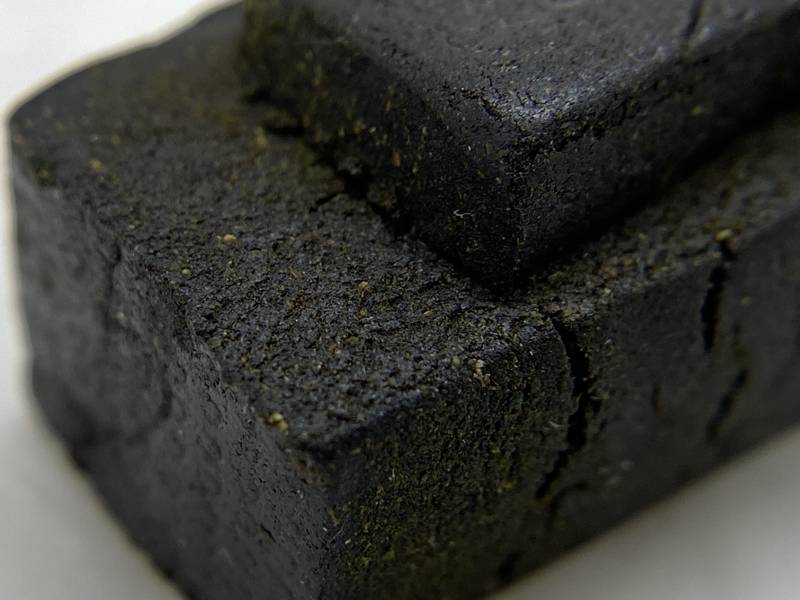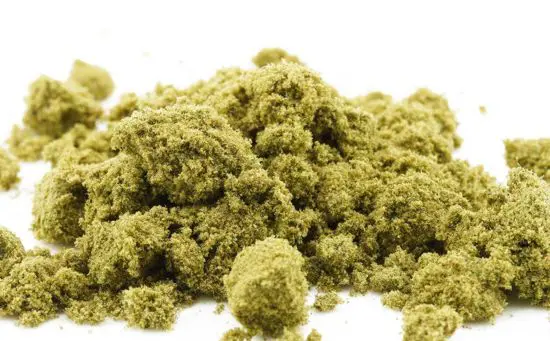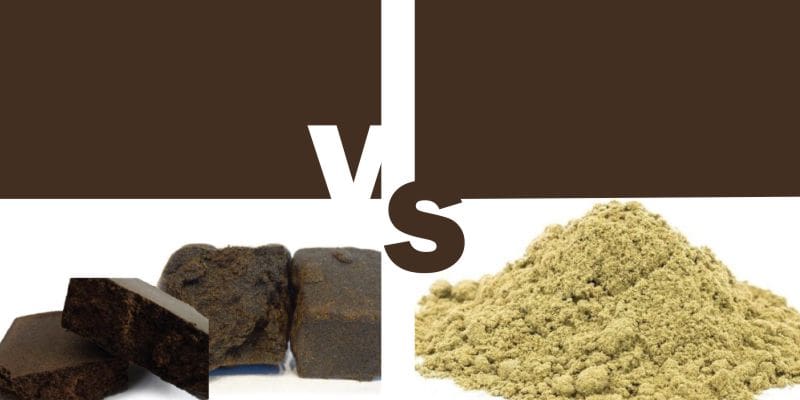In the world of cannabis, the battle for supremacy rages on between two potent contenders: Hash and Kief. These two cannabis extracts have long captivated enthusiasts with their unique qualities and effects. While Hashish has earned a reputation for its concentrated potency and distinct spicy flavors, Kief boasts its fine texture and versatility. In this head-to-head showdown, we’ll explore the characteristics of Hash vs Kief, their production methods, and ultimately determine who will reign supreme in the realm of cannabis extracts and enthusiasts.
What is Hash?

Jamaican Gumball Hash – my review
Hash is a cannabis concentrate that is made by extracting the resinous trichomes from the plant. Trichomes are the tiny, crystal-like structures that contain the cannabinoids and terpenes responsible for the effects and flavors of cannabis. These trichomes are collected, processed, and then compressed, resulting in a concentrated product known as hash.
The Process of Making Hash
The process of making hash involves separating the trichomes from the plant material. This can be done using various methods, such as dry sieving, ice water extraction, or using solvents like butane or ethanol. Each method has its own unique characteristics and results in different types of hash, which we will explore later in this article.
Different Types of Hash
Hash comes in a variety of forms, each with its own texture, color, and potency. Some popular types of hash include Moroccan hash, Afghan hash, Lebanese hash, and bubble hash. Moroccan hash is known for its light brown color and a crumbly texture, while Afghan hash is dark and sticky. Lebanese hash is often dark and soft, whereas bubble hash gets its name from the way it bubbles when heated.
How Hash is Consumed
Hash can be consumed in several ways. One popular method is by smoking it in a pipe or a vaporizer. The heat activates the cannabinoids and terpenes, allowing them to be inhaled and absorbed into the bloodstream. Another method is by adding hash to food or drinks, where it can be infused into oils or butter and then used in cooking or baking. This method, known as edible consumption, provides a longer-lasting and more intense effect.
What is Kief?
Kief, also known as pollen or dry sift, is another potent form of cannabis concentrate. It is made up of the resinous trichomes that have been separated from the plant material. Unlike hash, kief is in its raw, unprocessed form, consisting of tiny crystals that are rich in cannabinoids and terpenes.
The Process of Making Kief
The process of making kief involves collecting the trichomes by sifting or shaking the cannabis flowers. This can be done using a mesh screen or a specialized grinder with a kief catcher. As the flowers are ground, the trichomes fall through the screen into a collection chamber, resulting in a fine powder-like substance known as kief.
Different Methods of Collecting Kief
There are various methods to collect kief, ranging from using simple tools like screens or grinders to more advanced techniques like dry ice sifting or using a tumbler. Each method allows for the separation of the trichomes, resulting in different qualities and quantities of kief.
How Kief is Consumed
Kief can be consumed in several ways. It can be sprinkled on top of a bowl of cannabis flower or added to a joint, enhancing the potency and flavor. Kief can also be pressed into hash or used to make other cannabis-infused products, such as edibles or topicals. Its fine consistency makes it easy to incorporate into various consumption methods.
Hash Vs Kief
Quality and Potency
When it comes to determining the quality of hash and kief, several factors come into play. These factors include the overall appearance, aroma, potency, and effects from the product.
Determining the Quality of Hash
The quality of hash is often assessed based on its color, texture, its ability to crumble well and the presence of impurities. High-quality hash tends to have a golden or brownish hue, indicating a well-purged product. It should also have a sticky yet pliable texture and be free from plant material or contaminants.
Determining the Quality of Kief
Similar to hash, the quality of kief can be determined by its color, texture, and purity. High-quality kief is light in color, indicating a cleaner extraction process. It should have a powdery and dry consistency, without any moisture or clumps. The more vibrant and potent the color, the higher the quality of the kief.
Comparing the Potency of Hash and Kief
Both hash and kief are concentrated forms of cannabis, resulting in higher potency compared to traditional flower buds. However, the potency can vary depending on the strain used and the extraction method employed. Generally, kief is considered to be more potent than hash due to its raw and unprocessed nature.
Good quality hash should have a THC percentage of between 40% to 60%, while good quality kief should be in the range of 50% to 80% THC.
Flavor and Aroma
The flavor and aroma of cannabis products play a significant role in the overall experience. Hash and kief each offer unique profiles that can be influenced by strain selection and extraction methods.
Flavor Profile of Hash
Hash has a diverse flavor profile that can range from earthy and spicy to sweet and fruity. The flavor is influenced by the specific strains used and the terpene profile present in the trichomes. Different strains can result in different flavors, allowing for a wide range of options to suit individual preferences.
Aromatic Properties of Kief
Kief also possesses aromatic properties that contribute to its overall appeal. The scent can vary from strain to strain, with some kief exhibiting floral, citrus, or pine notes, while others are gassy. This aromatic quality enhances the experience when consuming kief, providing an additional sensory dimension.
Different Strains and Their Impact on Flavor
Both hash and kief can be made from various cannabis strains, each with its own unique terpene profile. This diversity allows for a broad spectrum of flavors and aromas to be experienced. Some strains may have a more pronounced flavor, while others may be more subtle. Experimenting with different strains can provide an opportunity to explore a variety of flavors.
Texture and Consistency
The texture and consistency of hash and kief can greatly impact the smoking experience and ease of consumption.
Texture Variations in Hash
Hash can exhibit different textures, ranging from soft and pliable to hard and brittle. Softer hash is typically easier to work with, allowing for effortless manipulation when rolling joints or packing bowls. Harder hash may require more effort and heat to break apart and crumble into smaller pieces for use.
Consistency Variations in Kief
Kief has a consistently fine and powdery texture, regardless of the strain or extraction method. This unique consistency allows kief to be easily sprinkled or added to other cannabis products. Its fine nature also makes it ideal for pressing or compressing into hash, enhancing its versatility.
How Texture Affects the Smoking Experience
The texture of both hash and kief can significantly impact the smoking experience. Softer and more pliable hash tends to burn more evenly and smoothly, resulting in a flavorful smoke. The fine consistency of kief allows it to combust easily, producing a potent and aromatic smoke.
Methods of Consumption
Hash and kief offer a variety of consumption methods, each with its own unique benefits and effects.
Different Ways to Consume Hash
Hash can be consumed by smoking it in a joint, pipe, bong, or vaporizer. The most common method is to crumble the hash and mix it with cannabis flower before rolling it into a joint or packing it into a bowl. This allows for the cannabinoids and terpenes in the hash to be activated and inhaled. Hash can also be made into TCH edibles, providing a more discreet and long-lasting effect.
Different Ways to Consume Kief
Kief can be consumed in a similar fashion to hash. It can be sprinkled on top of a bowl of cannabis flower, enhancing the potency and flavor of the smoke. It is also often mixed in with flower when rolling a joint or blunt. Kief can also be pressed into hash or added to other cannabis-infused products, such as edibles or topicals. The versatility of kief allows for various creative consumption methods.
Comparing the Effects of Each Method
The effects of consuming hash and kief can vary depending on the method of consumption. Smoking hash or kief can provide a more immediate and intense high, while ingesting it through edibles offers a slower onset but longer-lasting effects. The desired effects can also be influenced by the strain used, personal tolerance, and dosage.
Cost and Availability
The cost and availability of hash and kief can vary depending on geographical location and local regulations.
Availability of Hash Online
Domestic and imported hash from Hash MOMs is easily found with AA to AAAA premium hash offerings. You can buy hash online by the gram and in larger increments, right up to one pound slabs.
Availability of Kief Online
You can buy Kief online quite easily from numerous dispensaries. It’s graded using the AA – AAAA system. In my experience, AAAA-grade kief is the only way to go for maximum potency, effect and flavor.
Comparing the Cost of Hash and Kief
The cost of hash and kief can vary depending on factors such as grade, potency, and market demand. Generally, hash tends to be more expensive than kief due to the additional processing and purification involved. However, prices can fluctuate, and it’s important to consider different brands and suppliers when comparing costs.
Medical Applications
Both hash and kief have potential medical applications, offering relief to individuals experiencing certain conditions.
The Medical Potential of Hash
Hash has been used for medicinal purposes for centuries. Its concentrated cannabinoid and terpene content make it useful for managing pain, reducing inflammation, and mitigating nausea. The various consumption methods allow for precise dosing and control, making it a valuable option for medical cannabis patients.
The Medical Potential of Kief
Kief, like hash, contains high levels of cannabinoids and terpenes, making it suitable for medical use. Its fine consistency makes it easy to incorporate into different formulations and delivery methods. Kief can be used to create tinctures, capsules, or topicals, providing relief for various conditions, including chronic pain and muscle spasms.
Comparing the Effectiveness in Treating Specific Conditions
The effectiveness of hash and kief in treating specific conditions can vary depending on the individual and the desired therapeutic outcome. Some patients may find that hash provides better relief, while others may prefer the versatility and ease of use that kief offers. It is important for patients to work with healthcare professionals to determine the most suitable treatment option.
Market Trends
The hash and kief markets are continuously evolving, influenced by changing consumer preferences and shifting regulations.
Current Trends in the Hash Market
In recent years of cannabis legalization, there has been a growing interest in hash, especially among cannabis enthusiasts seeking highly potent and flavorful experiences. This increased demand has led to a focus on quality extraction methods, strain selection, and innovative product offerings. Additionally, the legalization of cannabis in more regions has expanded the hash market, allowing for increased accessibility and variety.
Current Trends in the Kief Market
The kief market has also experienced growth and innovation in response to changing consumer demands, but it’s not as popular as hashish. Many cannabis consumers appreciate the versatility and convenience of kief, leading to an expanding market. As regulations continue to evolve, the kief market is expected to follow suit, providing more options and choices for consumers.
Future Predictions for the Industry
The hash and kief industry is expected to continue growing as cannabis legalization expands globally. As consumer preferences and demands evolve, more advanced extraction methods, innovative products, and improved quality control standards are expected to emerge. Additionally, research into the medical potential of hash and kief may further shape the industry and contribute to the development of specific formulations and dosage options.
Hash Vs Kief: What Ranks Supreme? – The Final Verdict

In the fast-paced arena of cannabis concentrates, two prominent players emerge as crowd favorites: Hash and Kief. Each has its unique merits and drawbacks, leaving enthusiasts often torn between the two. Now that I dived into the nitty-gritty details of Hash and Kief—from their production methods and types to their quality, potency, and medical benefits—let’s finalize the discussion with a comprehensive pros and cons list, followed by a conclusive summary.
Pros and Cons of Hash
Pros:
- Concentrated Potency: Hash tends to be highly concentrated, offering a unique potent experience.
- Diverse Flavors: The various types of hash bring a range of artisan flavors, from spicy to woodsy.
- Versatility in Consumption: Hash can be smoked in a pipe and in joints, vaped, or used in edibles.
- Long-lasting Effects: Especially when consumed as edibles, hash can offer longer-lasting effects.
- Medical Potential: Rich in cannabinoids and terpenes, hash is effective for various medical applications like pain relief.
Cons:
- Cost: Hash generally tends to be more expensive than Kief due to the additional processing involved.
- Texture Variability: The consistency can vary, sometimes making it hard to work with.
- Quality Assurance: Lower-quality hash may contain impurities.
Pros and Cons of Kief
Pros:
- Raw Potency: Kief is in its raw form and generally considered more potent than hash.
- Easy to Collect: Kief is easy to collect using simple tools like grinders.
- Flexibility in Use: Its fine texture makes it versatile for various consumption methods.
- Lower Cost: Usually cheaper than hash.
- Medical Versatility: Easy to incorporate into medical applications like tinctures and topicals.
Cons:
- Potency Variability: The potency can vary depending on how it was collected.
- Less Flavor Complexity: Kief may not offer the depth of flavor that hash can.
- Shorter-lasting Effects: When smoked or vaped, the effects may not last as long as those of hash.
The Final Verdict
When it comes to Hash and Kief, the winner isn’t so easily determined. Your choice might hinge on multiple factors like the desired potency, flavor complexity, medical needs, or even budget considerations. Hash offers a rich, diverse flavor profile and tends to be more desired in the marketplace, but it usually comes at a higher cost. Kief, on the other hand, offers raw potency and flexibility, albeit sometimes lacking the complex flavors found in hash.
So, who reigns supreme in the battle of Hash vs Kief? The answer is subjective and varies from person to person. Both have their merits and are champions in their own right. In an industry that thrives on diversity and personal preference, maybe the real victory is having the freedom to choose.
Cheers to the evolving world of cannabis extracts!
The Chronic Beaver



